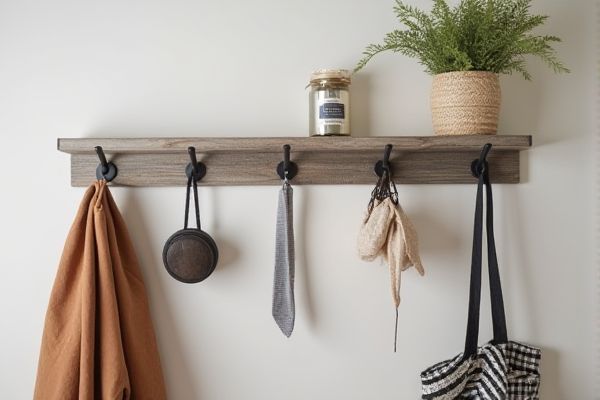
A hook rack offers versatile hooks that can hold heavier items and adapt to various spaces, while a peg rail typically features evenly spaced pegs designed for hanging lighter objects like hats or coats. Discover which option best suits your space and organization needs by reading the rest of the article.
Table of Comparison
| Feature | Hook Rack | Peg Rail |
|---|---|---|
| Design | Individual hooks mounted on a bar or base | Row of pegs or knobs aligned on a rail |
| Capacity | Supports multiple heavy items like bags, coats | Typically holds lighter items such as keys, hats |
| Installation | Wall-mounted, requires screws or anchors | Wall-mounted, usually screwed or nailed in place |
| Material | Metal, wood, plastic options available | Primarily wood or metal |
| Space Efficiency | Compact, utilizes vertical wall space | Can accommodate more items across rail length |
| Best Use | Entryways, garages, kitchens for hanging heavy items | Bathrooms, bedrooms for lightweight accessories |
Introduction to Hook Racks and Peg Rails
Hook racks and peg rails serve as practical storage solutions designed to organize items efficiently in homes and offices. Hook racks typically feature individual hooks spaced evenly on a single board or strip, providing easy access to hanging coats, bags, or keys. Peg rails consist of a horizontal rail with removable or fixed pegs, allowing more flexible arrangement and customization for hanging a variety of objects.
Key Differences Between Hook Racks and Peg Rails
Hook racks feature individual hooks spaced for hanging coats, bags, or hats, offering more flexibility in placement, whereas peg rails consist of a continuous wooden rail with pegs evenly spaced for a classic, uniform look. Hook racks typically support heavier items due to sturdier hooks, while peg rails are generally designed for lighter accessories like scarves or keys. Material variety in hook racks often includes metal or plastic components, contrasting with peg rails that are predominantly wooden, emphasizing aesthetic and structural differences.
Materials and Durability Comparison
Hook racks are commonly made from metal alloys, wood, or heavy-duty plastic, offering high durability and resistance to wear, making them suitable for holding heavier items. Peg rails, often crafted from solid wood or MDF, provide a classic look but may lack the robustness needed for substantial weight, potentially showing signs of wear over time. Your choice between a hook rack or peg rail should consider the material quality and durability requirements for the intended usage environment.
Design and Aesthetic Appeal
Hook racks often feature individual hooks with varied shapes and finishes, providing a versatile and decorative option that complements modern and rustic interiors. Peg rails present a more streamlined and minimalist look, usually consisting of evenly spaced pegs mounted on a wooden or metal strip, perfect for Scandinavian or contemporary decor styles. Both designs enhance organization while serving as functional art, but the choice depends on whether a more eclectic or uniform visual impact is desired.
Installation and Mounting Tips
Hook racks typically require wall anchors or studs for secure installation, making them ideal for heavier items; use a level to ensure even placement and mark drilling points precisely. Peg rails often come with pre-drilled holes and are easier to mount directly onto drywall using standard screws, suitable for lighter objects such as hats or keys. For both, selecting appropriate hardware based on wall type--drywall, plaster, or concrete--is crucial to ensure stability and avoid damage.
Space Efficiency and Storage Capacity
Hook racks maximize space efficiency by allowing multiple items to hang vertically in tight areas, making them ideal for small rooms or entryways with limited wall space. Peg rails offer versatile storage capacity with customizable peg arrangements that can hold heavier or bulkier items, adjusting to changing storage needs. Choosing the right option depends on your available wall space and the variety of items you need to organize efficiently.
Versatility in Home Organization
Hook racks offer versatile home organization by providing multiple hooks at varying heights, ideal for hanging coats, bags, and keys in entryways or kitchens. Peg rails feature adjustable pegs that can be repositioned or removed to customize spacing for different items like hats, scarves, or utensils, enhancing adaptability in storage solutions. Your choice between hook racks and peg rails depends on the specific needs of your space and the types of items you want to organize efficiently.
Cost and Budget Considerations
Hook racks tend to be more affordable and easier to install, making them a budget-friendly option for organizing your space efficiently. Peg rails often require a higher upfront investment due to their durable materials and more complex installation process but offer greater versatility for customizing storage. Evaluating your specific organization needs alongside these cost differences helps you choose the most economical solution without sacrificing functionality.
Maintenance and Longevity
Hook racks typically require less maintenance due to their solid construction and fewer moving parts, making them more durable for long-term use. Peg rails, often made from wood or lightweight materials, may need regular tightening and refinishing to prevent wear and tear or loosening over time. Choosing materials like stainless steel or high-quality hardwood can significantly enhance the longevity of either storage solution.
Which Option is Best for Your Space?
Choosing between a hook rack and a peg rail depends on your space's layout and storage needs. Hook racks offer sturdy, individual hooks ideal for hanging heavier items like coats or bags, making them perfect for entryways or mudrooms. Peg rails provide more flexibility, allowing you to adjust or add pegs for various items, making them suitable for customizable organization in kitchens or craft rooms.
 homyna.com
homyna.com